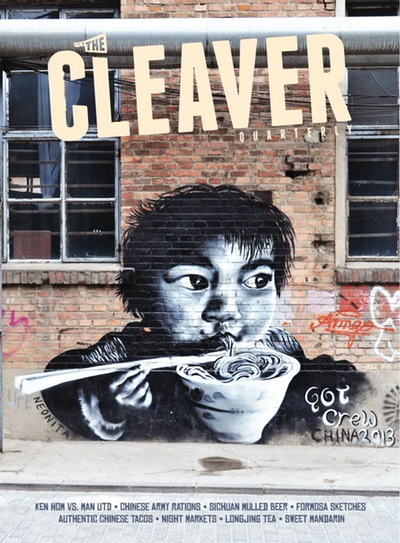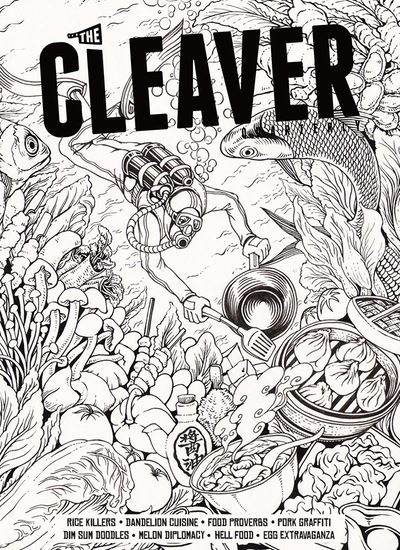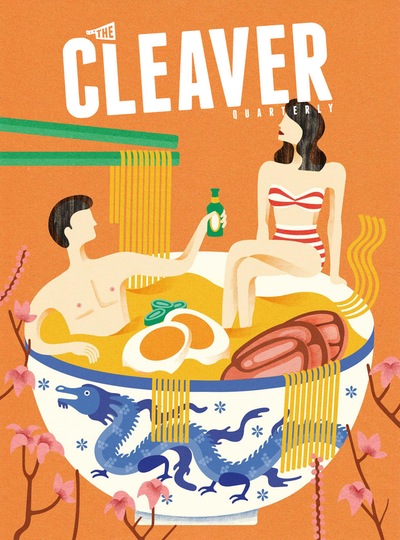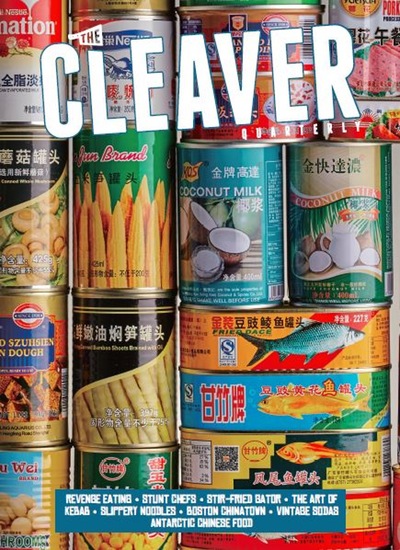
The Cleaver Quarterly One
Things you learn from issue one
How to make good tea taste like old boots. What sides to serve with roast locust. The most palatable protein in the People's Liberation Army M.R.E. meal set (hint: yak jerky). Where to find the best doggone Chinese takeout in Springfield, Missouri. How a legendary cleaverman once carved a thousand oxen without losing the edge on his trusty blade. The secret to perfectly plump Hakka rice dumplings. The difference between homestyle sesame paste and the cheap slop they serve in restaurants. Two sides of an intractable dispute at the heart of Dragon Boat Festival: sweet or savory zongzi? How to turn a can of Pabst Blue Ribbon into medicinal Sichuanese lager.
Featured contributors
Carolyn Phillips, Lichia Liu, Scott Seligman, Nick Otto

The Cleaver Quarterly Two
Things you learn from issue two
What goes in a Hakka Turducken (hint: ginseng stuffed in a sparrow, stuffed in a pigeon, stuffed in a pullet, stuffed in a puppy, stuffed in a pig stomach). The appropriate chaser for a celebratory bowl of fresh pig's blood. How curdled yoghurt looks after a shepherd in Inner Mongolia dries it on the roof of his yurt. Kublai Khan's philosophy on vegetables. How to start a knife fight on a Tajik feast day. Where to get good African stew in Guangzhou. Which U.S. state has the most Chinese restaurants per capita. An evolutionary theory to explain loempia, humongous Dutch-Chinese spring rolls.
Featured contributors
Fuchsia Dunlop, Fiona Reilly, Sue Zhou, Nick Jumara, Jessie Levene

The Cleaver Quarterly Three
Things you'll learn from issue three
Best dining practices on long distance train rides across mainland China. Eleven verbs that mean "cut." How to pick between fried dumplings, steamed dumplings, soup dumplings, boiled dumplings and more. A Chinese granny's eating tips on how to survive past ninety. How baozi adapt to international palates from Toronto to Tel Aviv. An appreciation for vintage enamelware. The key to the mystery of the three-headed duck soup. Why Yunnan gourmands insist on eating poisonous mushrooms, plus eighteen more culinary oddities from Yunnan cuisine. The story behind that ding-a-ling-a-ling Chinatown font. What resentments develop when an intrepid laowai decides to zuo yuezi, to live a week on a traditional postpartum diet for new mothers, for no good reason at all. A killer recipe for a hot buckwheat tea toddy.
Featured contributors
Des Bishop, Annabel Jackson, Charlie Stein, Cedric Yeh

The Cleaver Quarterly Four
Things you'll learn from issue four
How Marco Polo turned a plate of Gansu-style "twisted fish" into trofie al pesto. Why a remote county in western China celebrates an American politician by eating honeydew melons. How a comic book artist viewed the last days of a Hong Kong street market. What happens when a Beijing graffiti collective takes on rising pork prices. Thirteen ways to cook eggs. The poundage of a record-breaking rice dumpling. Why the Canadian Embassy's Beaver Liaison Officer (seriously) refers to Suzhou as "Soupzhou." How to substitute for unavailable ingredients when cooking Chinese in the West Indies (hint: think mojo criollo and caramelized brown sugar). What to feed your ancestors on Tomb Sweeping Festival.
Featured contributors
Linda Lau Anusasananan, Gabriella Zanzanaini, Taylor Holliday, Lance Crayon, Brian Evans, Jonathan Jay Lee

The Cleaver Quarterly Five
Things you'll learn from issue five
The origin story of a longstanding Mexican-Chinese greasy spoon. Grandma's best Hakka food recipes. What HBO's "The Wire" teaches us about Chinese food. How a Chicago chef resurrected a nearly extinct style of colonial Macanese food. A taxonomy of xiao long bao. Seven classic Chinese breakfast meals. A recipe for Cantonese bone broth. The secret ingredient at the best Chinese restaurant in mid-century Honolulu. The funkiest street foods in China (hint: it's a toss-up between spicy rabbit heads and dry-rubbed gator skin). How to mix a baijiu cocktail.
Featured contributors
Cathy Erway, Georgia Freedman, Matt Gross, Frank Kasell

The Cleaver Quarterly Six
Things you'll learn in issue six
Why the Mandarin word for "tomato" translates literally to "barbarian eggplant," plus other etymological curiosities. What the bit of red ribbon tied around the neck of a Kweichow Moutai bottle is actually good for. How to love baijiu. The strange history of the New England chow mein sandwich. What time the best jianbing stall in Tianjin opens for breakfast. How a Scottish botanist stole the secrets of Chinese tea cultivation from the Empire of the Great Qing. The long path of the 1769 summer harvest from the tea terraces of Fujian to the Boston Tea Party. Also, Thomas Jefferson's favorite Chinese green tea.
Featured contributors
Anne Mendelson, Derek Sandhaus, Alfreda Murck

The Cleaver Quarterly Seven
Things you’ll learn from issue seven
How to grill an egg Uyghur-style. The challenges of living with a professional barehanded stir-fry stunt chef. Why Western-trained chefs marvel at Chinese wok masters. The rise and fall of vintage Chinese sodas (top flavors: hawthorn, blackcurrant, birch sap, chrysanthemum, osmanthus flower). A cocktail recipe inspired by Beijing hutong weasels. How a Song Dynasty street food vendor invented youtiao as a culinary act of political protest. How two adventurous chefs turned China's polar research station into the hottest Chinese restaurant in Antarctica. What to order on a Tang Dynasty date night (hint: carp tail and orangutan lips).
Featured contributors
Andrew Leonard, Christina Chung, Kathi Maio

The Cleaver Quarterly Eight
Things you’ll learn from issue eight
How one foodie's visit to her local farmer's market stirred awake memories of a family legacy from colonial Shanghai. Why medieval Turks ate their macaroni with chopsticks. Imaginary recipes for mythical proteins. A simple takeout test to find the best egg rolls in town. How a humble pepper-taro stew from wartime China earned the name "Scorched Earth War Of Resistance." Ezra Pound's go-to Chinese spot in 1930s London. A 250-year-old ginseng teacake recipe fit for an emperor. The trouble with translating Chinese dish names into English. The next best thing to a dragon sandwich (hint: go to Hebei and ask for the donkey burger).
Featured contributors
Kian Lam Kho, Dianne Jacob, Paul French








